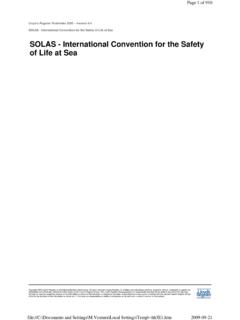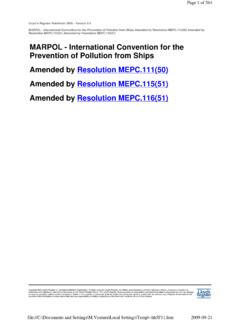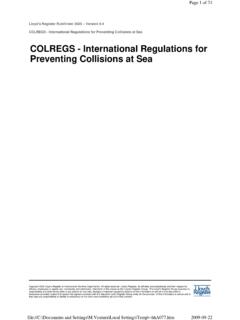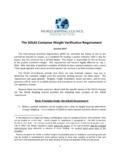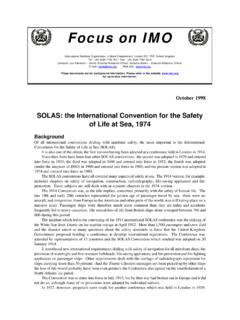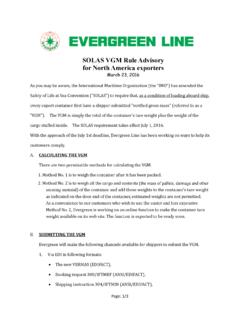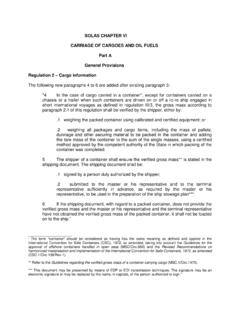Transcription of Safety of Life at Sea, 1974 (SOLAS) - ULisboa
1 1 Safety of life at Sea, 1974 (SOLAS)Prof. Manuel VenturaShip Design IMSc in Marine Engineering and Naval ArchitectureChapter II-2. Construction Fire Protection, Fire Detection and Fire ExtinguishingManuel - Fire Protection3 Fire Protection, Detection and Extinguishing (1) This Chapter was totally reviewed in the Amendments published onDecember 2000 [Resolution (73)] Entry into force on the 1st of July 2002 Alterations: The new version focus the attention more on the processes associated to fire scenariosthan on the types of ships, as previously. New Part E- Operational Requirementsthat deals exclusively with the human factors, such as education, training and maintenance issues.
2 New Part Fthat establishes a methodology for the approval of alternative or innovative designs and arrangements. Some technical details of the systems have been moved to the International Fire Safety Systems (FSS) - Fire Protection4 Fire Protection, Detection and Extinguishing (2)PART A - GENERAL Regulation 1. Application Regulation 2. Fire Safety objectives and functional requirements Regulation 3. DefinitionsPART B - PREVENTION OF FIRE AND EXPLOSION Regulation 4. Probability of Ignition Regulation 5. Fire growth potential Regulation 6. Smoke generation potential and - Fire Protection5 Fire Protection, Detection and Extinguishing (3)PART C- SUPPRESSION OF FIRE Regulation 7.
3 Detection and alarm Regulation 8. Control of smoke spread Regulation 9. Containment of fire Regulation 10. Fire fighting Regulation 11. Structural integrityPART D - ESCAPE Regulation 12. Notification of crew and passengers Regulation 13. Means of - Fire Protection6 Fire Protection, Detection and Extinguishing (4)PART E - OPERATIONAL REQUIREMENTS Regulation 14. Operational readiness and maintenance Regulation 15. Instructions, onboard training and drills Regulation 16. OperationsPART F - ALTERNATIVE DESIGN AND ARRANGEMENTS Regulation 17. Alternative design and arrangementsPART G - SPECIAL REQUIREMENTS Regulation 18. Helicopter facilities Regulation 19. Carriage of dangerous goods Regulation 20.
4 Protection of vehicle, special category and ro-ro spaces4 PART - Fire Protection8 Reg. 1 - Application1. Application2. Applicable requirements to existing ships3. Repairs, alterations, modifications and outfitting4. Exemptions5. Applicable requirements depending on ship type6. Application of requirements for - Fire Protection9 Reg. 2 - Fire Safety Objectives and Functional Requirements1. Fire Safety objectives2. Functional requirements3. Achievement of the fire Safety - Fire Protection10 Fire Safety Objectives Preventthe occurrence of fire and explosion; Reduce the risk to lifecaused by fire Reduce the risk of damage caused by fire to the ship, its cargo and the environment Contain.
5 Control and suppressfire and explosion in the compartment of origin Provide adequate and readily accessible means of escapefor passengers and - Fire Protection11 Functional Requirements Division of the ship into main vertical and horizontal zoneswith structural and thermal boundaries Separation of the accommodations from the remainder of the ship with structural and thermal boundaries Restricted use of combustible materials Detection of any fire in the zoneof origin Containment and extinguishing of any fire in the compartmentof origin Protection of the means of escape and access for firefighting Fire firefighting appliances available and ready Minimize the possibility of ignition of flammable cargo - Fire Protection12 Some Definitions (1) Accommodation Spaces-spaces used for public spaces, corridors, lavatories, cabins, offices, hospitals, cinemas, game and hobby rooms, barber shops, pantries containing no cooking appliances and similar spaces Category A Machinery Spaces are the spaces and the trunks for the spaces that contain: Internal combustion engines used for propulsion Other internal combustion engines that all together have a totalpower > 375 kW Any oil fired boiler or other oil burning equipment (inert gas generators, incinerators, etc.)
6 - Fire Protection13 Some Definitions (2) Non-Combustible Materials- materials that do not burn or release flammable vapors up to 750 C, during the standard fire test. Standard Fire Tests- tests carried out in a oven, in which parts of the relevant bulkheads or deck are raised to temperatures corresponding to the standard time-temperature curve. The tested parts must: Have an exposed area not less than m2 and height (or length) not less than m. Include a joint (where appropriate) - Fire Protection14 Some Definitions (3) The standard time-temperature curveis a fair curve interpolating the following points measured above the initial temperature of the oven:925 C60 min823 C30 min708 C15 min659 C10 min556 C5 - Fire Protection15 Some Definitions (4)Class A Divisions Built in steel or other equivalent material Suitably stiffened Built to be capable of preventing the passage of smoke and flame to the end of the one-hour Insulated with approved non-combustible materials such that the average temperature of the unexposed side will not rise more than 140 C above the origin al temperature, nor will the temperature, at any one point, including any joint, rise more than 180 C above the original temperature, within the following time intervals: A60 - 60 min.
7 A30 - 30 min. A15 -15 min A0 -0 - Fire Protection16 Some Definitions (5)Class B Divisions Constructed of approved non-combustible materials Built to avoid the passage of flames during at least 30 minutes of the standard test Insulated such that the average temperature of the unexposed side will not rise more than 140 C, nor will the temperature at any one point, including any joint, rise more than 225 C above the original temperature, after: B15 - 15 min. B0 - 0 C Divisions Constructed of approved non-combustible materials, without any particular B - PREVENTION OF FIRE AND - Fire Protection18 Cargo Tank Venting (Oil Tankers) The venting systems of cargo tanks shall be entirely distinct from the air pipes of the other compartments of the ship Shall be designed to minimize the possibility of flammable vapoursbeing admitted to enclosed spaces containing a source of ignition The venting arrangements in each cargo tank may be independent or combined with other cargo tanks and May be incorporated into the inert gas - Fire Protection19 Cargo Tank Venting (cont.)
8 Vent outlets for cargo loading, discharging and ballasting shall: Permit the free flow of vapour mixtures, or Permit the throttling of the discharge of the vapour mixtures to achieve a velocity >= 30 m/s; Be so arranged that the vapour mixture is discharged vertically upwards Where the method is by free flowthe outlets shall be located at: Height > 6 m above deck More than 10 m apart from any air intakes for confined spaces containing possible sources of ignition and from deck machinery Where the method is by high-velocity discharge, the outlets shall be located at Height > 2 m above deck More than 10 m from the nearest air intakes and from deck machinery The outlets shall be provided with high-velocity devicesPart C.
9 Suppression of - Fire Protection21 Detection and Alarm1. Purpose2. General requirements3. Initial and periodical tests4. Protection of machinery spaces5. Protection of accommodation and service spaces and control stations6. Protection of cargo spaces in passenger ships7. Manually operated call points8. Fire patrols in passenger ships9. Fire alarm signaling systems in passenger - Fire Protection22 Control of Smoke Spread1. Purpose2. Protection of control stations outside machinery spaces3. Release of smoke from machinery spaces4. Draught stops5. Smoke extraction systems in atriums of passenger - Fire Protection23 Containment of Fire1. Purpose2. Thermal and structural boundaries3.
10 Penetration in fire resisting divisions and prevention of heat transmission4. Protection of openings in fire-resisting divisions5. Protection of openings in machinery spaces boundaries6. Protection of cargo space boundaries7. Ventilation - Fire Protection24 Fire Fighting1. Purpose2. Water supply systems3. Portable fire extinguishers4. Fixed fire extinguishing systems5. Fire-extinguishing arrangements in machinery spaces6. Fire extinguishing arrangements in control stations, accommodation and service spaces7. Fire extinguishing arrangements in cargo spaces8. Cargo tank protection9. Protection of cargo pump-rooms in tankers10. Fire-fighter s - Fire Protection25 Water Supply SystemsFixed Fire Fighting System Ships shall be provided with fire pumps, fire mains, hydrants and hosesCapacity of the Fire Pumps: Passenger Ships Not less than 2/3 of the flow rate of the bilge pumps.


